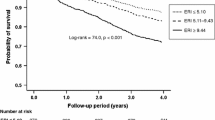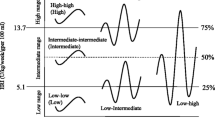Abstract
Background
Responsiveness to erythropoietin-stimulating agent (ESA) may be associated with mortality risk in hemodialysis (HD) patients. The aim of the present study was to assess the relationship between responsiveness to ESA and long-term outcome in chronic HD patients.
Methods
Patients on HD therapy for more than 6 months were enrolled in this cohort study. The first year was used to assess the longitudinal dialysis status of patients; the subsequent years were used to assess the time-dependent risk of all-cause mortality. Hazard ratios were estimated using a Cox proportional model for the association between ESA dose and hemoglobin (Hb) level and mortality, adjusting for potential confounders. The ESA resistance index (ERI) was determined as the weekly weight-adjusted dose of ESA divided by Hb concentration. Patients were divided into three groups by tertiles of ERI.
Results
Of the 320 subjects enrolled, 105 died during the follow-up period of 70.4 ± 29.0 months. When subjects were stratified by epoetin dose and Hb level into four groups, those who had low Hb despite a high dose of epoetin were associated with the highest risk of mortality among the four groups (adjusted hazard ratio 1.86; 95 % confidence interval 1.25–2.75). These highest risk subjects had older age, lower body mass index, and lower serum levels of albumin, triglyceride, and transferring saturation. The impact of serum albumin and serum ferritin on mortality risk in an adjusted Cox proportional hazards model was in accordance with low Hb and higher ESA. There was no significant difference between the mortality risk and tertile of ERI.
Conclusions
High ESA dose and low Hb level were associated with an increased risk of all-cause mortality. However, the responsiveness to ESA estimated by ERI was not related to mortality risk. These findings suggest that the responsiveness to ESA should be evaluated by different methods in HD patients.




Similar content being viewed by others
References
Eschbach JW, Egrie JC, Downing MR et al (1987) Correction of the anemia of end-stage renal disease with recombinant human erythropoietin. Results of a combined phase I and II clinical trial. N Engl J Med 316:73–78
Macdougall IC, Cooper A (2002) The inflammatory response and epoetin sensitivity. Nephrol Dial Transplant 17(Suppl 1):48–52
Zhang Y, Thamer M, Stefanik K et al (2004) Epoetin requirements predict mortality in hemodialysis patients. Am J Kidney Dis 44:866–876
Kilpatrick R, Critchlow C, Fishbane S et al (2008) Greater epoetin alfa responsiveness is associated with improved survival in hemodialysis patients. Clin J Am Soc Nephrol 3:1077–1083
Locatelli F, Pisoni R, Combe C, Bommer J, Andreucci VE, Piera L, Greenwood R, Feldman HI, Port FK, Held PJ et al (2004) Anaemia in haemodialysis patients of five European countries: association with morbidity and mortality in the Dialysis Outcomes and Practice Patterns Study (DOPPS). Nephrol Dial Transplant 19:121–132
Robinson BM, Joffe MM, Berns JS et al (2005) Anemia and mortality in hemodialysis patients: accounting for morbidity and treatment variables updated over time. Kidney Int 68:2323–2330
Szczech LA, Barnhart HX, Inrig JK et al (2008) Secondary analysis of the CHOIR trial epoetin-alpha dose and achieved hemoglobin outcomes. Kidney Int 74:791–798
Johnson DW, Pollock CA, Macdougall IC (2007) Erythropoiesis-stimulating agent hyporesponsiveness. Nephrology (Carlton) 12:321–330
Kalantar-Zadeh K, Lee GH, Miller JE et al (2009) Predictors of hyporesponsiveness to erythropoiesis-stimulating agents in hemodialysis patients. Am J Kidney Dis 53:823–834
KDOQI Clinical practice guidelines and clinical practice recommendations for anemia in chronic kidney disease (2006) Am J Kidney Dis 47 (5 Suppl 3): S16–S145
Locatelli F, Aljama P, Bárány P (2004) European best practice guidelines working group: Revised European best practice guidelines for the management of anaemia in patients with chronic renal failure. Nephrol Dial Transplant 19 (Suppl 2): ii1-ii47
Akizawa T, Pisoni RL, Akiba T (2008) Japanese haemodialysis anaemia management practices and outcomes (1999–2006): results from the DOPPS. Nephrol Dail Transplant 23:3643–3653
Chung S, Song HC, Shin SJ et al (2012) Relationship between erythropoietin resistance index and left ventricular mass and function and cardiovascular events in patients on chronic hemodialysis. Hemodial Int 16:181–187
Daugirdas JT (1993) Second generation logarithmic estimates of single-pool variable volume Kt/V: an analysis of error. J Am Soc Nephrol 4:1205–1213
Gejyo F, Saito A, Akizawa T et al (2004) Japanese society for dialysis therapy. Ther Apher Dial 8:443–459
Regidor D, Kopple J, Kovesdy C (2006) Associations between changes in hemoglobin and administered erythropoiesis-stimulating agent and survival in hemodialysis patients. J Am Soc Nephrol 17:1181–1191
Szczech LA, Barnhart HX, Sapp S et al (2010) A secondary analysis of the CHOIR trial shows that comorbid conditions differentially affect outcomes during anemia treatment. Kidney Int 77:239–246
Fukuma S, Yamaguchi T, Hashimoto S et al (2012) Erythropoiesis-stimulating agent responsiveness and mortality in hemodialysis patients: results from a cohort study from the dialysis registry in Japan. Am J Kidney Dis 59:108–116
Kalantar-Zadeh K, McAllister CJ, Lehn RS et al (2003) Effect of malnutrition-inflammation complex syndrome on EPO hyporesponsiveness in maintenance hemodialysis patients. Am J Kidney Dis 42:761–773
Stenvinkel P (2001) The role of inflammation in the anaemia of end-stage renal disease. Nephrol Dial Transplant 16(Suppl 7):36–40
Smrzova Jm Balla J, Barany P (2005) Inflammation and resistance to erythropoiesis-stimulating agents-What do we know and what needs to be clarified? Nephrol Dial Transplant 20 (Suppl 8): viii2–viii7
Abe M, Okada K, Maruyama T, Maruyama N, Matsumoto K, Soma M et al (2011) Relationship between erythropoietin responsiveness, insulin resistance, and malnutrition-inflammation-atherosclerosis (MIA) syndrome in hemodialysis patients with diabetes. Int J Artif Organs 34:16–25
Kaysen GA, Muller HG, Ding J, Chertow GM (2006) Challenging the validity of the EPO index. Am J Kidney Dis 47:157–166
Nakai S, Iseki K, Itami N et al (2012) An overview of regular dialysis treatment in Japan (as of 31 December 2010). Ther Apher Dial 16:483–521
Hasegawa T, Bragg-Gresham JL, Pisoni RL et al (2011) Changes in anemia management and hemoglobin levels following revision of a bundling policy to incorporate recombinant human erythropoietin. Kidney Int 79:340–346
Acknowledgments
The authors are very grateful to dialysis staff who understood the clinical importance of this study and who provided high-quality data in Hidaka Hospital. This study was in part supported by a grant from Japan Promotion Society for Cardiovascular Disease.
Conflict of interest
The authors have no conflicts of interest to declare.
Author information
Authors and Affiliations
Corresponding author
Rights and permissions
About this article
Cite this article
Ogawa, T., Shimizu, H., Kyono, A. et al. Relationship between responsiveness to erythropoiesis-stimulating agent and long-term outcomes in chronic hemodialysis patients: a single-center cohort study. Int Urol Nephrol 46, 151–159 (2014). https://doi.org/10.1007/s11255-013-0494-z
Received:
Accepted:
Published:
Issue Date:
DOI: https://doi.org/10.1007/s11255-013-0494-z




